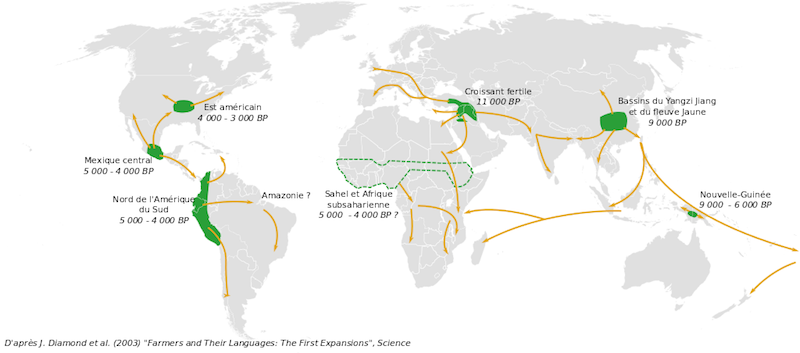The Origins of Agriculture
Episode #5 of the course Human history and the first civilizations by Brian Fagan
Welcome to Lesson 5! Now we enter a new chapter of the human past. For the first time, we acquired food by growing or taming it, rather than by hunting and foraging for plant foods.
Farming and Herding
No one “invented” agriculture. Everyone knew that plants germinated and yielded edible fruit, roots, or seeds. The deliberate planting of seed-yielding grasses or tuber-producing plants like potatoes was a strategy that developed from observing plants in the wild over thousands of years among people with an intimate knowledge of their environments.
Almost certainly plant cultivation began when there were shortfalls of easily accessible wild grass harvests. About 11,000 years ago, a thousand-year drought settled over the Middle East. We know from excavations into Syrian villages that wild grasses became much scarcer. So, people began to plant seeds to improve natural stands. The strategy worked. Genetic changes in the plants that made harvesting more controllable followed. At the same time, wild goats, sheep, and pigs, common hunting prey, were corralled and bred in captivity.
Food Production Spreads
By 9000 BC, food production—agriculture and herding—were well-established in the Middle East. The new economies spread rapidly into the lowlands of what is now southern Iraq between the Tigris and Euphrates rivers, perhaps by 8000 BC, and into the Nile Valley at about the same time. By 6000 BC, agricultural societies were settling across Europe, using animals and crops that had originated in the eastern Mediterranean area.

Centres of origin and spread of agriculture.
Food production also developed independently in other parts of the world. Cereal farmers were active in northern China’s Yellow River valley by about 8000 BC. Rice was domesticated in the Yangtze valley in the south by about the same time. Rice farming spread widely through southeastern Asia and in southern Asia. There, cereal agriculture was well-established in the Indus Valley by 6000 BC.
Native American societies developed a remarkable expertise with both wild and domesticated plants. The staple of life in later times was maize, first domesticated in Central America, perhaps by 5000 BC. Maize, a tropical plant, spread widely in different strains, into the North American Southwest by 2500 BC, into eastern North America, and as far north as the St, Lawrence Valley somewhat later. Corn was cultivated alongside a wide range of other native plants.
In South America, potatoes were cultivated high in the Andes mountains by 4000 BC, as was another staple, ulluco. Unlike the Old World, Native Americans had no draft animals except the llama, used in the Andes. All agriculture was carried out by hand, sometimes with skilled use of irrigation.
Consequence of Agriculture and Herding
Agriculture and animal domestication changed history profoundly. People were now anchored to their fields and herds. Permanent agricultural villages with substantial dwellings became commonplace. Early farming societies placed a major emphasis on kin ties. In time, more elaborate societies emerged in some areas.
But no farming or herding community was completely self-sufficient. So, every village traded with neighbors and with other groups who controlled sources of fine toolmaking stone, ornamental shells, or basic commodities such as grain or animal hides. Trade, hand-to-hand exchange, became a vital component of farming societies.
Those who controlled key trade goods like salt or shiny obsidian (volcanic glass used for toolmaking and ornaments) acquired social prominence and attracted followers other than just fellow kin. In time, some kin groups acquired importance, prestige, and leadership roles.

Ploughing with a yoke of horned cattle in Ancient Egypt. Painting from the burial chamber of Sennedjem, c. 1200 BC.
Over many centuries, farming societies became more complex. One example is the large village at Çatalhöyük in Central Turkey, which became prosperous off the obsidian trade. But there was more. Some houses in the village served as shrines that commemorated the ancestors, the guardians of the land. Here, too, the people commemorated wild bulls, symbols of fertility, and honored a woman goddess.
The consequence? Civilization!
Between 8000 and 3100 BC, farming became established over enormous areas of the world. Some of these societies became complex, kin-based entities with large villages. In some exceptionally favored areas like Mesopotamia, the land between the Tigris and Euphrates, and Egypt’s Nile Valley, these societies and their leaders forged the world’s first urban civilizations. In the next lesson, we’ll look at just how these societies came into being.
Recommended book
The Agricultural Revolution in Prehistory: Why did Foragers become Farmers? by Graeme Barker
Share with friends
